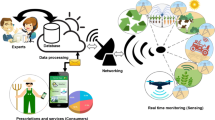Abstract
In recent years, applications of the Internet of Things (IoT) have become a part of our everyday life. Wireless multimedia sensor networks (WMSNs) are a new and emerging application of IoT that contain sensor nodes equipped with cameras, microphones, and other sensors producing multimedia content. ZigBee is the most common standard radio protocol used in WMSNs because of its lightweight standard and its low-cost and low-power characteristics. Most ZigBee network systems are constructed using the tree topology. Using the root node, intermediate nodes, and leaves of this topology, packets can be easily forwarded to the next hop by the tree routing mechanism, which calculates the packet destination address using the distributed address assignment mechanism. However, network parameter constraints cause the orphan node problem. Therefore, we proposed a novel recommendation scheme, the ZigBee connectivity enhancement mechanism (ZCEM), based on the improvement probability and improvement effect of multiparent nodes (MNs) in ZigBee networks. The ZCEM chooses MNs with better IP to connect to other parent nodes to increase the connectivity of ZigBee networks, reducing the number of orphan nodes. The ZCEM is compared to the standard ZigBee mechanism and the ZigBee connectivity-improving mechanism (ZCIM). The results show that the proposed ZCEM improves connectivity in ZigBee networks. The proposed mechanism can achieve a join ratio of 90%, approximately 3% more efficient than the ZCIM, and is 6% more efficient than the standard ZigBee mechanism.
















Similar content being viewed by others
References
Ahamed SR (2009) The role of zigbee technology in future data communication system. J Theor Appl Inf Technol 5(2):129–135
Alliance, Z (2004) ZigBee Specification: ZigBee Document 053474r06 Version 1.0. December 14th.
Baker N (2005) ZigBee and Bluetooth: strengths and weaknesses for industrial applications. Comput Control Eng 16(2):20–25
Chang HY, Huang SC, Lai CC, Hong ZH (2014) A Novel Recommendation Scheme for Increasing Connectivity in ZigBee Wireless Sensor Networks. In Intelligent Information Hiding and Multimedia Signal Processing (IIH-MSP), Kitakyushu, 674–677
Chung SM, Kim KT, Song J, Youn HY (2016) Enhancing node connectivity by utilizing RSSI for ZigBee-based WSN. International Conference on Information and Communication Technology Convergence (ICTC), Jeju Island, Korea, 555–560
Ding G, Sahinoglu Z, Bhargava B, Orlik P, Zhang J (2005) Reliable broadcast in ZigBee networks. The Second Annual IEEE Communications Society Conference on Sensor and Ad Hoc Communications and Networks, Santa Clara, pp 510–520
Ding G, Sahinoglu Z, Orlik P, Zhang J, Bhargava (2006) B. Tree-based data broadcast in IEEE 802.15.4 and ZigBee networks. IEEE Trans Mob Comput 5(11):1561–1574
Hu SC, Lin CK, Tseng YC, Chen WT (2014) Distributed address assignment with address borrowing for ZigBee networks. IEEE International Conference on Communications Workshops (ICC), Sydney, Australla, 454–459
Lin TL, Zeng XQ, Chang HY (2013) An address-contention approach based on a time-division multiplexing mechanism for ZigBee networks. International Journal of Distributed Sensor Networks, Article ID 505121, 8 pages
Nath SK, Aznabi S, Islam NT, Faridi A, Qarony W (2017) Investigation and performance analysis of some implemented features of the ZigBee protocol and IEEE 802.15.4 Mac specification. Int J Online Eng 13(1):14–32
Pan MS, Tsai CH, Tseng YC (2009) The orphan problem in ZigBee wireless networks. IEEE Trans Mob Comput 8(11):1573–1584
Roy UK (2017) Source-initiated routing to support large-scale pseudo-linear ZigBee networks. In Proceedings of the First International Conference on Intelligent Computing and Communication, Singapore, 645–653
Song TW, Yang CS (2008) A connectivity improving mechanism for ZigBee wireless sensor networks. IEEE/IFIP Int Conf Embedded Ubiquit Comput 2:495–500
Sun G, He Y, Li Z, Wang Z (2016) An IP format based algorithm for ZigBee routing protocol optimization. J Comput Commun 4(07):48–54
Wu CM, Chang RS, Lee PI, Yen JH (2013) An innovative scheme for increasing connectivity and life of ZigBee networks. J Supercomput:1–18. doi:10.1007/s11227-011-0696-z
Xie HF, Zeng F, Zhang GQ, & Su DL (2016) Simulation research on routing protocols in zigbee network. In Proceedings of the 6th International Asia Conference on Industrial Engineering and Management Innovation, Atlantis Press, 891–898
Acknowledgements
This work was supported by Ministry of Science and Technology (MOST) project of Taiwan [MOST 105-2221-E-415-024-].
Author information
Authors and Affiliations
Corresponding author
Rights and permissions
About this article
Cite this article
Chang, HY. A connectivity-increasing mechanism of ZigBee-based IoT devices for wireless multimedia sensor networks. Multimed Tools Appl 78, 5137–5154 (2019). https://doi.org/10.1007/s11042-017-4584-2
Received:
Revised:
Accepted:
Published:
Issue Date:
DOI: https://doi.org/10.1007/s11042-017-4584-2




